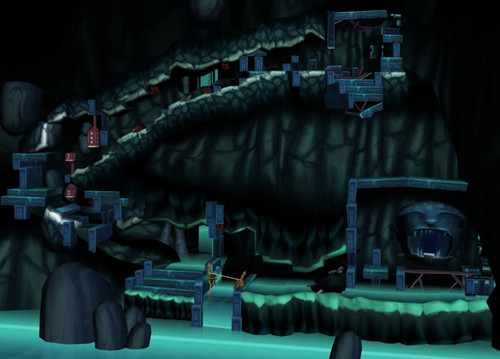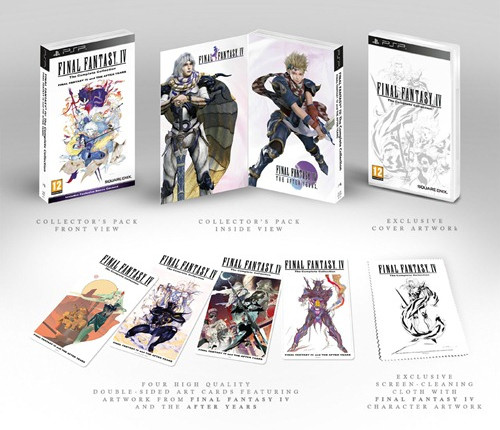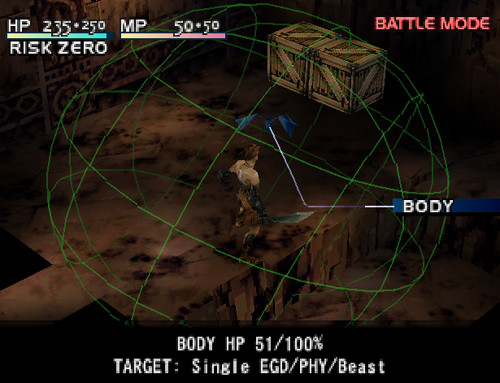- remind me tomorrow
- remind me next week
- never remind me
The X Button
Nightmare Girls
by Todd Ciolek,

This past Sunday brought an unfortunate surprise: Chinatown Fair, the last arcade in Chinatown and the best arcade in New York City, shut down.
Chinatown Fair was in business for many years, and it saw the arcade boom of the 1980s, the fighting-game craze of the early 1990s, and the lean times of the past decade. Arcades grew less and less important to the game industry in the last ten years, with most small mom-and-pop operations giving way to franchises like Dave and Buster's and other attempts at grown-up versions of Chuck E. Cheese.
Yet Chinatown Fair stuck around, and it was a gathering point for anyone who was in New York with an interest in fighting games. To step into Chinatown Fair was to return to the 1990s, when arcades were full of kids getting upset and excited and savagely competitive over the latest fighting game. The Fair also kept up to date. In an age when most new arcade fighters are hard to find in the wild, you could count on Chinatown Fair to have BlazBlue and Super Street Fighter IV. Their last acquisition was The King of Fighters XIII, a game that might only ever exist in arcade form, if rumors about SNK's fortunes are true.
I enjoyed seeing big-name arcade fighters at Chinatown Fair, but my favorite thing about the place was the chance to play games I'd rarely see anywhere else. Few arcades outside of Japan would have Melty Blood or Arcana Heart or the swiftly dismissed Rage of the Dragons running, but Chinatown Fair did. In fact, it's The Rumble Fish 2 that I remember best. The Rumble Fish 2 is an largely unremarkable Dimps-made fighter with a routine lineup of characters (except for the old guy in the Hawaiian shirt). It's the sort of standard fighter that I probably wouldn't give a second look in MAME, but I always dropped a buck into it when I visited Chinatown Fair. It's not every arcade that keeps The Rumble Fish 2 around. And it's not every arcade that's a genuine loss when it closes.
You can see photos from Chinatown Fair's last few hours here. You can also read a retrospective on the arcade from ANN's own David “Astro Toy” Cabrera, who went there much more often than I did.
NEWS
STING'S GUNGNIR DOESN'T WANT TO HURT YOU
You know Sting, right? They're the workhorse developer of both standard RPGs like Hexyz Force and strange experiments like Knights in the Nightmare. Well, their latest, Gungnir lands in somewhat familiar territory: it's a PSP strategy-RPG about a semi-average young warrior who wields a legendary weapon.

The warrior is Julio, and the weapon is an allegedly god-owned spear called Gungnir. In the game's world of class warfare, Julio's part of a rebel movement that opposes the Gargantia Empire, and he's nice enough to rescue a woman named Alyssa from a slave auction. Alyssa's one of the game's playable characters, along with revolutionary leader Rangus and self-proclaimed holy messenger Elise. And Julio, of course. Gungnir appears to be the ninth game in the Dept. Heaven series that also includes Riviera and Yggdra Union, so there might be some character crossovers.
Sting evidently doesn't want to tax players too heavily with Gungnir's story or its gameplay. The battle system is deliberately simple, and its strategy-RPG battles use a gauge that lets players change the turn order of allies and enemies. This opens up chances for combo attacks and, one assumes, last-second rescues of damaged characters. Gungnir's developers say the game is intended for those who aren't particularly good at strategy-RPGs, and their exercise in boosting player self-esteem comes out May 19 in Japan.
CAVE STORY SIMPLY CANNOT BE REMADE ENOUGH
Cave Story was first an indie PC game, then a PSP game, then a DSiWare game, and then a WiiWare game. Now it's headed for the one system that doesn't really emphasize old-fashioned, side-scrolling games: the Nintendo 3DS. Of course, this means that Cave Story must be remade entirely into a 3-D game, and that's what developer Nicalis aims to do.

The game's premise remains unchanged even in its 3-D revamp: a robot named Quote wakes up in the depths of a floating island. His memory wiped, he finds his way through a strange world of rabbit-eared mimiga creatures, human interlopers, and some dark secrets. It's all arranged in Metroid fashion, with Quote gaining access to new areas as he upgrades his weapons and abilities. The 3-D version promises a few new stages that the game's director/programmer/writer/artist/creator, Daisuke “Pixel” Amaya, cut from the original game.
Cave Story's NES-like looks and appealing characters earned the game plenty of fans when it was the PC-based creation of just one man. Yet the game didn't have the same impact when it arrived on handheld systems, and it's not clear if a 3-D remake will enrapture new followers. NIS America hopes to have the game out within the 3DS “launch window,” which could be any time between the system's March 27 debut and the E3 in June.
SQUARE ENIX DELIVERS SPECIAL EDITIONS FOR EUROPE, VAGRANT STORY FOR U.S.
Square Enix announced a Final Fantasy IV: Complete Collection special edition…for Europe. The game comes in a fancy, hinged box, with four art cards and a special dust cloth. So you can wipe your PSP with Cecil. It joins the special European editions of The Third Birthday and Tactics Ogre, and it makes one wonder why Square Enix isn't doing anything like this in North America. Haven't companies like Atlus and NIS America proven that we enjoy throwing extra money at games just for some frivolous, closet-bound merchandise? I think they have.

This Complete Collection features visually enhanced versions of Final Fantasy IV and its After Years sequel, plus a bonus chapter that bridges the two games. In the Interlude, Cecil and his allies (including Rosa, Yang, Rydia, and twin mages Palom and Porom) ferret out an enemy threatening Castle Damcyan. The compilation arrives in North America this April 19 and hits Europe four days later.

But Square Enix is at least giving North America something that Europe has long enjoyed: Vagrant Story on the PlayStation Network. It's six dollars, it's out right now, and it's still one of the most intriguing PlayStation games. The work of Final Fantasy Tactics writer-director Yasumi Matsuno, it's filled with medieval-fantasy backstabbery and complex gameplay. Perhaps it's a bit too complex in the myriad weapons that players have to customize and swap in and out, and perhaps the storyline's mixture of action-movie undertones and Ye Olde Englishe is a bit much. But I don't think so. Vagrant Story's great, and you should all try it.
IMPORT ROUNDUP: FEBRUARY
CATHERINE Why are people paying attention to Catherine? Is it the game's overt sexuality? Probably, but countless other Japanese games are just as suggestive and even more grotesque about it. Is it the bizarre psychological mixture of its main character's real-life problems and surreal nightmares? I think it is. Despite ad images of its succubus heroine lounging on pianos and messily devouring pizza, Catherine has an intriguing premise: a thirty-ish salaryman named Vincent faces his own bleak, directionless life and the prospect of cheating on his long-term, commitment-minded girlfriend Katherine. His turmoil results in bizarre visions and run-ins with an alluring blonde woman named Catherine. It's Silent Hill covered by the Persona developers, with mental breakdowns and subconscious horrors lurking beneath the placidity of urban youth. The actual gameplay is stripped down to simple challenges: Vincent climbs, jumps, runs, and occasionally screams his way through shadowed dreamscapes filled with grotesquely symbolic creatures, block-pushing puzzles, and sheep-people. As if to compensate for the basic nature of Vincent's dreams, Atlus made the game so difficult that Japanese players demanded (and will apparently get) a patch to make things easier. Catherine has the look of something cannily aimed at the modern crossbreed of game geek and anime fan, but it might dig deeper. |
GALGUN There is no idea so promising that Japan's game industry can't hijack it and stuff it with blushing schoolgirls and creepy atmosphere. Take Galgun, for example. It's a shooting game featuring a cupid-like angel, and in more tasteful circumstances it'd be a cute gun game where the player fired romantic arrows at predestined couples. But GalGun instead has its yipping cupid heroine accidentally pump too much love-energy into an average high-school kid named Tenzou, thus making all of his female classmates pursue him like crazed Beatles fans back in 1965. His only means of escape is for the player to fire liquid pheromones at the oncoming schoolgirls, turning them into swooning, gasping, conveniently exposed, and non-threatening wrecks who collapse from pure ecstasy. When not fighting for Tenzou's romantic life, the player tries to set him up with the game's four non-crazed heroines, most of whom need saving from some sort of level-end boss. The game plays like a typical light-gun shooter without an actual light gun: players move on tracks through levels, firing upon phalanx after phalanx of teenage girls before they can kiss Tenzou or give him love notes. GalGun's overall tone can be summed up by two facts. One, there's a download that puts every character in a bikini. Two, there's a button that replaces the real game with a simple 8-bit screen, just in case you're caught playing GalGun by someone you respect.
|
MACROSS TRIANGLE FRONTIER Macross is perfect material for a video game, perhaps more so than any other anime series. After all, no other anime series has such spectacular battles between alien armadas and sleek jet-robots that transform three different ways and dodge 100,000 smoke-spouting missiles in one graceful spin. Most Macross games struggle to capture that exhilaration, but Atrdink's PSP shooters Macross Ace Frontier and Macross Ultimate Frontier didn't do such a bad job of it. They're followed now by Macross Triangle Frontier. Like its predecessors, it's a 3-D shooter with an astoundingly comprehensive list of Macross mecha, including even the VF-9 Cutlass from the largely forgotten Macross M3 Dreamcast game. The gameplay itself is a refinement of the past two Frontier shooters, with a new missile-lock system that's closer to the anime series in destructive satisfaction. The game's campaign mode pays new attention to two Macross series: the recent Macross Frontier and the widely detested, non-canonical Macross II: Lovers Again. Macross Frontier also gets an Academy mode, where a player-created character meets the cast and, of course, has romantic encounters with Frontier's female characters. Don't worry. There are fighters aplenty from the other Macross series, so you can pretend that it's a Robotech game if you like. |
MUCHI MUCHI PORK AND PINK SWEETS Muchi Muchi Pork and Pink Sweets show just how crafty Cave's grown with their shooters. Both are packed with modern otaku-magnet anime stylings, such as the voluptuous, pig-eared heroines of Muchi Muchi Pork and the roses and lingerie-wearing women of Pink Sweets. Most shooter fans don't care about that, though. They only care about how long they can dodge the game's fiendish volleys of enemy-spewed bullets, racking up a masterful score all the while. Muchi Muchi Pork carries its porcine theme into gameplay itself: the aircycle-riding stars destroy enemies to earn pig-shaped icons, which fill up a power meter (or a “lard meter,” a name that makes me dislike Muchi Muchi Pork a lot less) that in turn boosts the player's score. Pink Sweets features a bullet-canceling mechanic, a barrier system, and…well, lots of flower petals. The Xbox 360 package has the original arcade versions of both games, though fans will likely prefer the included “1.01” editions and their new features: for example, attacks are more powerful and last longer in Muchi Muchi Pork's case, while Pink Sweets 1.01 is more forgiving to players who happen to lose a ship. Not that any shooter fan would tolerate such weakness. Also enclosed are substantially remixed Arrange modes for each game, and there's a downloadable “Matsuri” edition of Muchi Muchi Pork bundled free with the first print run. And so Cave's business plan is intact, appealing to both the shooter faithful and the man-child connoisseur of anime sex appeal. Those who prefer more conventional shooters can opt for Dodonpachi Dai-Fukkatsu Black Label, also available now on the Xbox 360. It puts its robot-schoolgirl heroines into a less frilly world of jet fighters and giant tanks. |
NEXT WEEK'S RELEASES
POKEMON WHITE AND BLACK Who remembers the MAD magazine parody of Pokemon? Unleashed in the late 1990s, it was called “Hokeycon” and proclaimed its target “the latest fad to take your cash.” This biting satire failed to dent the marketing façade of Pokemon, and so next week brings a new installment of this 13-year-long fad: Pokemon White and Black. They're rehashes of the Pokemon formula with slight enhancements, as players once again explore a non-threatening modern fantasyland to capture and train various creatures for battle. But now those players can do this during different seasons, as Black and White change terrain, features, and available Pokemon as the months pass. Greater innovations lie in multiplayer modes, where the C-Gear feature allows Pokemon Black and White games to communicate without players' direct input, and there's even a Feeling Check that grants special items based on how well two players get along. Black and White are also notable for not featuring iconic electric rat Pikachu as a prominent Pokemon. He/she/it is in the game somewhere, but Black and White de-emphasize Nintendo's little yellow goldmine after twelve years of kids recognizing Pikachu more often than the last three U.S. Vice Presidents.
|
PHANTOM BRAVE: HEROES OF THE HERMUDA TRIANGLE Phantom Brave is an anomaly in the Nippon Ichi Software school of strategy-RPGs. Instead of using a standard grid for battles, it has all of its squat, cutesy characters roaming freely, with their movement and attacks limited by a point meter. Of course, Phantom Brave still shares a lot with other NIS games, including a goofball cast led by innocent little orphan Marona and her summoned ghost-warrior friend Ash. There's a sprawling story that begins as comedy and ends with yet another tragic battle against some ancient evil, but Phantom Brave also shares the NIS ideal of an exploitable battle system. In the gridless combat area, characters can bounce, slide, toss things around, or even knock each other off of the map entirely. As the third version of Phantom Brave, Heroes of the Hermuda Triangle includes five new characters: Unlosing Ranger from ZHP, Hero Prinny from the Prinny side-scrollers, Lord Zetta from Makai Kingdom, a playable version of Phantom Brave's own Castille, and recurring NIS cameo character Asagi. It also sports the extra cast members from the game's Wii version, and that includes Laharl, Flonne, and Etna from Disgaea. Putting them in every game is an NIS tradition. Oh, and the game also has Marona's alternate-world counterpart Carona, a young girl who's not wearing a whole lot. Unfortunately, that's also an NIS tradition.
|
Also Shipping: Dragon Age 2, the sequel to 2009's blood-drenched, grim 'n gritty medieval-fantasy RPG, arrives on the PlayStation 3 and Xbox 360.
discuss this in the forum (33 posts) |
this article has been modified since it was originally posted; see change history
 Developer: Atlus
Developer: Atlus Developer: Inti Creates
Developer: Inti Creates Developer: Artdink
Developer: Artdink Developer: Cave
Developer: Cave Developer: Game Freak
Developer: Game Freak Developer: Nippon Ichi Software
Developer: Nippon Ichi Software